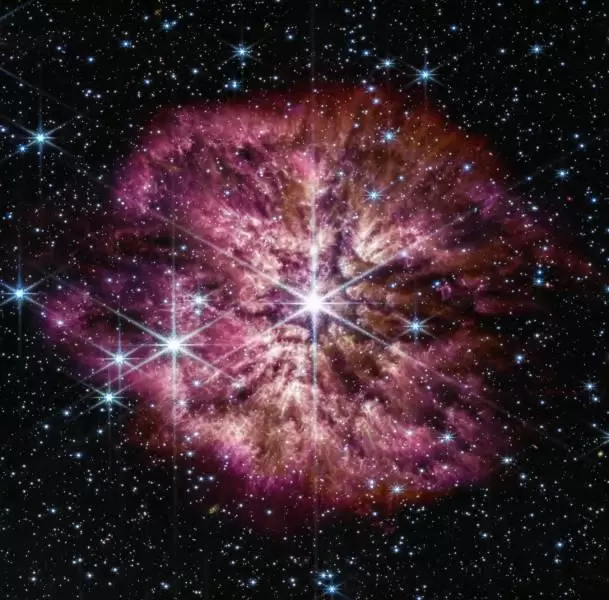James Webb Space Telescope has captured a rare sight in the vast universe: a star dying on the verge of a supernova. The telescope has taken pictures of a star in the Sagitta constellation that is about to go supernova. The detailed picture clearly shows the constellation and the star, which has amazed space fans worldwide.
Star Gone Supernova
Although the photograph was taken shortly after its launch towards the end of 2021, it was only made public this week. The James Webb Space Telescope utilized its infrared sensors to capture an image of a massive, hot star located 15,000 light years away, revealing all the gas and dust ejected into space. For reference, a light year is roughly equivalent to 5.8 trillion miles.

Macarena Garcia Marin, a European Space Agency scientist in this project, said, “We’ve never seen it like that before. It’s really exciting.”
The material that now forms the star’s outer layer was captured in a purple hue reminiscent of a cherry blossom. The Hubble space telescope had previously photographed the same star in transition a few decades ago, but the image lacked the intricate details and appeared more like a blazing fireball.
Scientists explain that this transformation process is unique to certain stars and is typically the final stage before they undergo a supernova explosion.
Read more: Gmail Creator Says ChatGPT Will Overtake Google in 2 Years
What is James Webb Space Telescope?
The James Webb Space Telescope (JWST) is a large, space-based observatory set to be launched by NASA in 2021. It is named after James E. Webb, a crucial figure in the early days of the U.S. space program.
The JWST is designed to be the successor to the Hubble Space Telescope and will be the largest, most powerful, and most complex space telescope ever built. Its primary objective is to observe some of the earliest galaxies in the universe, study the formation and evolution of stars and galaxies, and search for planets orbiting other stars.
The JWST is positioned at a point in space called the second Lagrange point (L2), which is about 1.5 million kilometres (930,000 miles) from Earth. This location will give the telescope a clear view of the universe without interference from the Earth’s atmosphere or the Sun’s glare.
The JWST uses a combination of infrared and visible light sensors to capture detailed images and spectra of celestial objects. Its mirrors are coated with a thin layer of gold to maximize their reflectivity, and its sun shield is made up of five layers of unique material that will protect the telescope from the heat of the Sun.
This is a great breakthrough for humanity and its constate strive to seek knowledge of the universe and what is out there in the vastness of space. The James Webb Space Telescope is the right step in the right direction!
